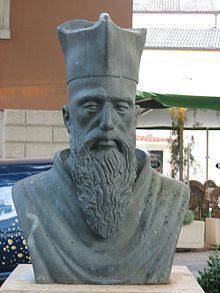Nationality Venetian | Died 13 December 1600 | |
 | ||
Full Name Petar Šimun Budinić Other names Piersimeone Budineo, Ssimvn Bvdineo/Ssimun Budineo, Zadranin Known for being author of the version of Latin script based on comparison with Cyrillic and Glagolitic, using diacritics from Czech orthography of Jan Hus Other name Piersimeone Budineo, Ssimvn Bvdineo/Ssimun Budineo, Zadranin | ||
Petar Šimun "Šime" Budinić Zadranin (Latin: Piersimeone Budineo) (1535 – 13 December 1600) was a 16th-century Catholic priest and writer from Zadar, Venetian Dalmatia (today Croatia). He was a translator of psalms and catechetical texts, promoter of post-Tridentine Catholicism, and a poet.
Contents
Early life
Budinić was born in Zadar in the period between 1530 and 1535 in a family that originated from the Zadar hinterland. His father was a goldsmith whose name was Mihovil and his mother Klara was from the De Sanctis family. He was most likely educated by the Franciscans from Zadar, and knew both the Glagolitic and Cyrillic scripts well. It is assumed that he completed elementary and humanist education in Zadar, and higher education in Padua.
Budinić became a Catholic priest in Zadar and advanced to the position of canon in 1560. Scholars disagree whether or not Budinić attended the Council of Trent. For many years Budinić was a notary in Zadar and chancellor in the Roman Catholic Archdiocese of Zadar. As chancellor he wrote official documents using the Glagolitic script. While Budinić was a notary he had a lot of spare time which he used to read love songs. He is first mentioned in documents in 1556. Between 1559 and 1561 he wrote verses of love songs in dodecasyllable, seven of them still preserved, some of them in honor of Pelegrinović's Jeđupka. At that time he also authored one short Latin language satire which subject were cheated husbands.
Budinić was a light-headed young priest who was even temporary expelled from Catholicism because of his misconduct, after he was reported for beating one of his fellow priests who swore his parents. Thanks to the influence of his family, this excommunication was abolished without endangering the advance in his career. In 1570 Budinić was appointed as chaplain of the Chapel of Saint Lucia on the island Pag and in 1577 he became chief vicar of the Archdiocese of Zadar.
Chakavian period
In June 1581, Budinić travelled to Rome at the invitation of the Holy See to promote counter-reformation policy. According to one 1626 letter, Pope Gregory XIII invited Budinić to Rome to translate Catichesis of Peter Canisius to Illyrian language using Illyrian characters. Pope Gregory XIII ordered Budinić to prepare Roman Catholic Catechism using Illyrian language and characters. It is unclear if Pope ordered any particular script. Although it is confirmed by many contemporary documents that Pope indeed ordered Budinić to prepare Roman Catholic Catechism using Illyrian language and characters it remain unclear if Pope ordered any particular script. When Budinić arrived to Rome he became a confessor in Pontifical Croatian College of St. Jerome where he worked on improvement of the Glagolitic missals and breviars.
During his stay in Rome Budinić wrote his first two books on the pure Croatian language of the Chakavian dialect. According to one 1581 Vatican document, Budinić was preparing a translation in the Serbian language (Latin: nella lingua serviana), which at that time in the Vatican and Dubrovnik was a term used for Cyrillic script, the preferred language for Vatican documents to be published regarding Slavic language.
Shtokavian period and orthographic reform
Budinić's intention was, from reasons of propaganda, to employ language and orthography that could penetrate and be understood in all of what was then the southern reaches of the Slavic people. Budinić attempted a daring orthographic reform and authored a version of the Latin script based on the Cyrillic and Glagolitic scripts, using diacritics (namely č and ž) from the Czech orthography of Jan Hus in his 1582 work. Some authors believed that Budinić, being promoter of Counter-Reformation, would never use orthography of Jan Hus who was a key predecessor to the Protestant Reformation.
Under the influence of Jesuit priest Peter Canisius, Budinić abandoned the language he had been using in his 1582 work, and instead used a mixture of the Shtokavian Serbo-Croatian, Church Slavonic, Czech, and Polish languages. Budinić referred to the language of his work as Slavonic. Budinić then published translations of Canisius' work in 1583 (Summa nauk Kristjanski) in two versions, Cyrillic and Latin, and created a complex script based on Ijekavian Shtokavian pronunciation. The Latin script edition was published for clergy while Cyrillic script edition was published for population. Budinić published Cyrillic script edition with intention to sprad this kind of book among South Slavs who were adherents of the Eastern Orthodox Church.
Legacy
Budinić died in Zadar on 13 December 1600, around the age of 65. The elementary school in Zadar bears Budinić's name. A square in Zadar was named Šime Budinić´s Square (Croatian: Poljana Šime Budinića).
